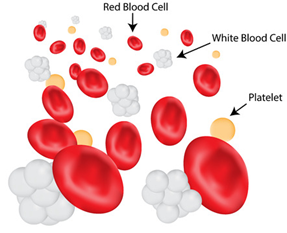Also
known as Thrombocyte Count PLT Platelet Distribution Width PDW Mean Platelet Volume
MPV
The platelet count is a test that determines the number of platelets in a person's
sample of blood. Platelets, also called thrombocytes, are tiny fragments of cells
that are essential for normal blood clotting.
Why Get Tested?
To determine the number of platelets in a sample of your blood as part of a health exam; to screen for, diagnose, or monitor conditions that affect the number of platelets, such as a bleeding disorder, a bone marrow disease, or other underlying condition.

When too Get Tested?
As part of a routine complete blood count (CBC); when you have
episodes of unexplained or prolonged bleeding or other symptoms that may be due to a
platelet disorder.
Sample Required ?
A blood sample drawn from a vein in your arm or by a fingerstick (children and adults) or heelstick (new-borns)
What is being tested ?
Platelets, also called thrombocytes, are tiny fragments of cells that are essential for normal blood clotting. They are formed from very large cells called megakaryocytes in the bone marrow and are released into the blood to circulate. The platelet count is a test that determines the number of platelets in a person's sample of blood.
When there is an injury to a blood vessel or tissue and bleeding begins, platelets help
stop bleeding in three ways.
They:
• Adhere to the injury site
• Clump together (aggregate) with other platelets
• Release chemical compounds that stimulate further aggregation of other platelets
These steps result in the formation of a loose platelet plug at the site of the injury in a process called primary haemostasis. At the same time, activated platelets support the coagulation cascade, a series of steps that involves the sequential activation of proteins called clotting factors. This secondary haemostasis process results in the formation of strands of fibrin that weave through the loose platelet plug, form a fibrin net, and compress to form a stable clot that remains in place until the injury has healed. When the clot is no longer needed, other factors break the clot down and remove it.
Each component of primary and secondary haemostasis must be present, activated at the right time, and functioning properly for adequate clotting. If there are insufficient platelets, or if platelets are not functioning normally, a stable clot may not form and a person may be at an increased risk of excessive bleeding.
Platelets survive in the circulation about 8 to 10 days, and the bone marrow must continually produce new platelets to replace those that degrade, are used up, and/or are lost through bleeding. Determining the number of platelets in blood with a platelet count can help diagnose a range of disorders having to do with too few or too many platelets.
When is it ordered?
A platelet count is often ordered as a part of a Complete Blood Count (CBC), which may be
done at the time of a routine health examination.
It may be ordered when a person has signs and symptoms associated with low platelets or
a bleeding disorder, such as:
• Unexplained or easy bruising
• Prolonged bleeding from a small cut or wound
• Numerous nosebleeds
• Gastrointestinal bleeding (which can be detected in stool samples)
• Heavy menstrual bleeding
• Small red spots on the skin called petechiae—may sometimes look like a rash
• Small purplish spots on the skin called purpura, caused by bleeding under the skin
Testing may also be done when it is suspected that an individual has too many platelets.
An excess of platelets can cause excessive clotting or sometimes bleeding if the
platelets are not functioning properly. However, people with too many platelets often
have no signs or symptoms, so the condition may be found only when a platelet count is
done as part of a health check or for other reasons.






